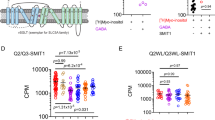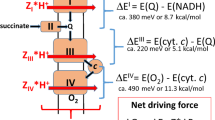Abstract
INHIBITION of metabolism leads to a gain of sodium and a loss of potassium by cells, and it is widely realized that the maintenance of concentration gradients of these ions between cells and plasma depends on a supply of energy from metabolism. This holds true for red cells that derive energy from glycolysis, for the majority of tissues that depend on respiration and for the few cells and tissues that actively transport cations with energy derived from either metabolic pathway. Cells appear to transport cations actively only when adenosine triphosphate (ATP) is being produced in situor is supplied from an exogenous source, such as by injection into poisoned squid giant axons1 or by introduction into red cells ghosts by the technique of ‘reversible hæmolysis’2. ATP is necessary, therefore, and its rate of production either by substrate or oxidative phosphorylation is one of the factors that determines the rate at which active transport occurs.
This is a preview of subscription content, access via your institution
Access options
Subscribe to this journal
Receive 51 print issues and online access
$199.00 per year
only $3.90 per issue
Buy this article
- Purchase on Springer Link
- Instant access to full article PDF
Prices may be subject to local taxes which are calculated during checkout
Similar content being viewed by others
References
Caldwell, P. C., Hodgkin, A. L., Keynes, R. D., and Shaw, T. I., J. Physiol., 152, 561 (1960).
Gardos, G., Acta Physiol. Acad. Sci. Hung., 6, 191 (1954). Whittam, R., Ph.D. thesis, Univ. Cambridge (1957). Hoffman, J. F., Fed. Proc., 19, 127 (1960).
Mudge, G. H., Amer. J. Physiol., 165, 113 (1951). Terner, C., Eggleston, L. V., and Krebs, H. A., Biochem. J., 47, 139 (1949). Pappius, H. A., and Elliott, K. A. C., Canad. J. Biochem. Physiol., 34, 1053 (1956).
Krebs, H. A., and Kornberg, H. L., Ergebn. Physiol., 49, 212 (1957). Lardy, H. A., and Wellman, H., J. Biol. Chem., 195, 215 (1952). Siekevitz, P., and Potter, V. R., J. Biol. Chem., 201, 1 (1953). Chance, B., and Williams, G. R., J. Biol. Chem., 217, 383 (1955).
Post, R. L., Merritt, C. R., Kinsolving, C. R., and Albright, C. D., J. Biol. Chem., 235, 1796 (1960). Dunham, E. T., and Glynn, I. M., J. Physiol., 156, 274 (1961).
Wheeler, K. P., and Whittam, R. (unpublished results).
Hess, H., and Pope, A., Fed. Proc., 16, 196 (1957). Jarnefelt, J., Biochim. Biophys. Acta, 48, 104 (1961).
Skou, J. C., Biochim. Biophys. Acta, 42, 6 (1960).
Whittam, R., and Davies, R. E., Nature, 173, 494 (1954).
Author information
Authors and Affiliations
Rights and permissions
About this article
Cite this article
WHITTAM, R. Active Cation Transport as a Pace-maker of Respiration. Nature 191, 603–604 (1961). https://doi.org/10.1038/191603a0
Issue Date:
DOI: https://doi.org/10.1038/191603a0
This article is cited by
-
Primary active sodium transport, oxygen consumption, and ATP: Coupling and regulation
Kidney International (1986)
-
Effects of phenylalanine and its deaminated metabolites on Na+, K+-ATPase activity in synaptosomes from rat brain
Neurochemical Research (1982)
-
Metabolic pathways coupled to H+ transport in turtle urinary bladder
The Journal of Membrane Biology (1980)
Comments
By submitting a comment you agree to abide by our Terms and Community Guidelines. If you find something abusive or that does not comply with our terms or guidelines please flag it as inappropriate.



